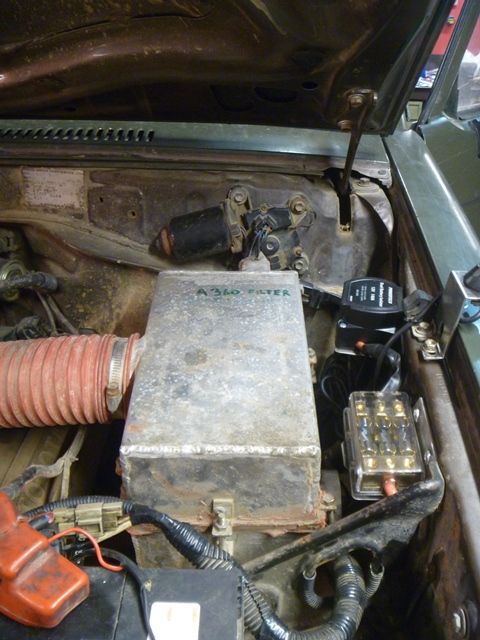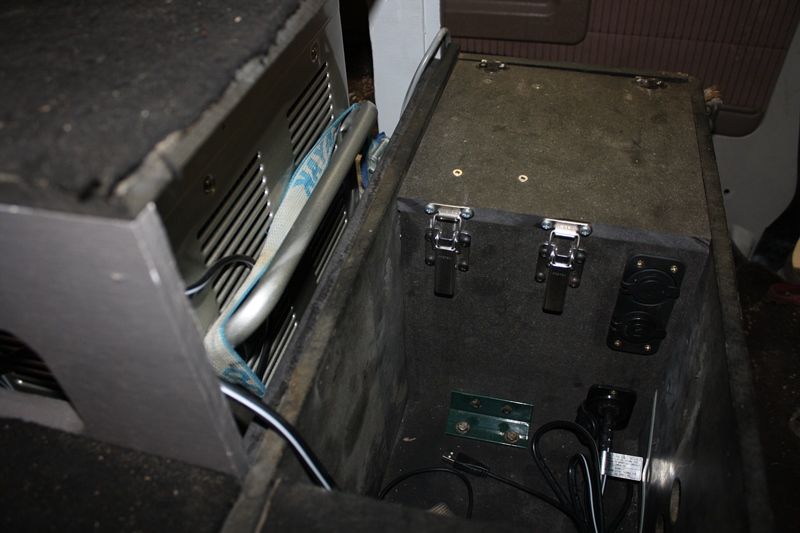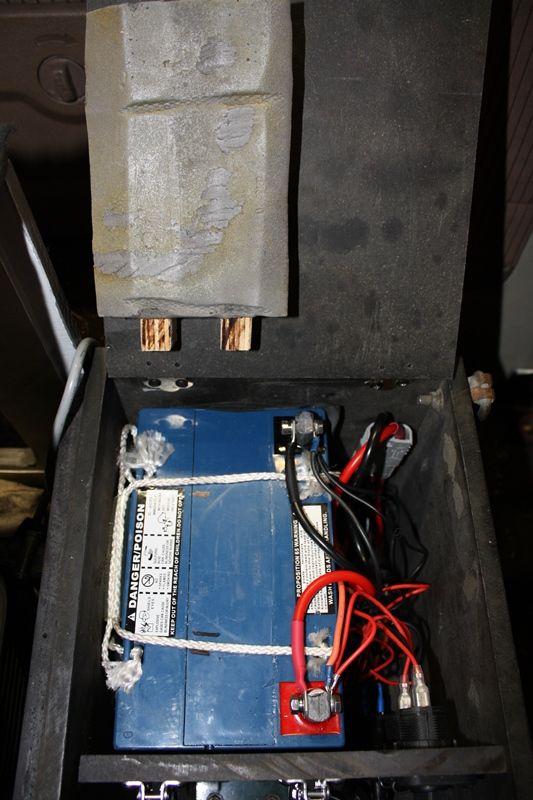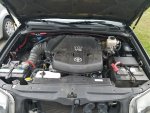You are using an out of date browser. It may not display this or other websites correctly.
You should upgrade or use an alternative browser.
You should upgrade or use an alternative browser.
How to make a cheap isolated dual-battery setup for $50
- Thread starter evldave
- Start date
dwh
Tail-End Charlie
The electromagnet in a non latching solenoid typically draws 1 amp or less, continuously as long as the solenoid is engaged. Same with a latching type, but it only draws for a split second until the latch engages.
What amperage rating you need for the main contacts depends on how many amps you expect it to carry.
For battery charging, depending on wire size and length, and battery resistance, you might see 100-150 amps for an hour or so - IF you've got a huge artery bank, huge wire and a huge alternator - and less and less after that as time goes by. (That's for lead-acid batteries. It's different for lithiums.)
For a typical truck with a single aux battery, you'd probably never see over 50a during charging.
BUT, if you are also trying to feed other big loads, like a winch or 2kw inverter, you could see a couple hundred amps through the solenoid.
For self jump, most starters draw 250a or less. Usually a LOT less, like 50-100a. But sometimes the starter does have to work hard, so it's best to plan and rig for the starter's full rated draw.
What amperage rating you need for the main contacts depends on how many amps you expect it to carry.
For battery charging, depending on wire size and length, and battery resistance, you might see 100-150 amps for an hour or so - IF you've got a huge artery bank, huge wire and a huge alternator - and less and less after that as time goes by. (That's for lead-acid batteries. It's different for lithiums.)
For a typical truck with a single aux battery, you'd probably never see over 50a during charging.
BUT, if you are also trying to feed other big loads, like a winch or 2kw inverter, you could see a couple hundred amps through the solenoid.
For self jump, most starters draw 250a or less. Usually a LOT less, like 50-100a. But sometimes the starter does have to work hard, so it's best to plan and rig for the starter's full rated draw.
MikeWeaver
Member
That's a very interesting yet simple guide, I will probably give it a try on my TLC80.
giarc1234
New member
So after reading all the post in this tread I decided to wire the second battery up. I added a bussman fuse/relay box in the mix to keep the number of relays in the engine compartment to a min. Thanks for the great write up and all the great advice in this thread.
Attachments
I've read, re-read, and read portions again...
So far I'm still looking at where to mount the 2nd battery like was done in the Jeep pix.
I'm deciding between one of these VSR's so I won't be bothered with switching etc.
http://www.ebay.com.au/itm/12V-DUAL...UAL-SENSING-CIRCUIT-VERY-SMART-/181653631902?
or
https://www.amazon.com/Cole-Hersee-48530-Battery-Isolator/dp/B00LMGPHW2
My 100W solar panel came in and I'm still deciding on charge controllers.
Other than that this has been a very helpful thread.
More good reading at: http://www.fridge-and-solar.net/dual_bat.htm
So far I'm still looking at where to mount the 2nd battery like was done in the Jeep pix.
I'm deciding between one of these VSR's so I won't be bothered with switching etc.
http://www.ebay.com.au/itm/12V-DUAL...UAL-SENSING-CIRCUIT-VERY-SMART-/181653631902?
or
https://www.amazon.com/Cole-Hersee-48530-Battery-Isolator/dp/B00LMGPHW2
My 100W solar panel came in and I'm still deciding on charge controllers.
Other than that this has been a very helpful thread.
More good reading at: http://www.fridge-and-solar.net/dual_bat.htm
dwh
Tail-End Charlie
I've read, re-read, and read portions again...
So far I'm still looking at where to mount the 2nd battery like was done in the Jeep pix.
I'm deciding between one of these VSR's so I won't be bothered with switching etc.
http://www.ebay.com.au/itm/12V-DUAL...UAL-SENSING-CIRCUIT-VERY-SMART-/181653631902?
or
https://www.amazon.com/Cole-Hersee-48530-Battery-Isolator/dp/B00LMGPHW2
My 100W solar panel came in and I'm still deciding on charge controllers.
Other than that this has been a very helpful thread.
More good reading at: http://www.fridge-and-solar.net/dual_bat.htm
Another option:
https://www.amazon.com/Cole-Hersee-48530-Battery-Isolator/dp/B00LMGPHW2
That can be wired with force on/force off if you want (bring your own switch). Also can add an LED indicator light (again, bring your own).
Last edited:
dwh
Tail-End Charlie
Crap...just noticed I posted the wrong link...disregard that link in the above post, here's the correct link...
https://www.amazon.com/Samlex-ACR-1...qid=1494559485&sr=1-1&keywords=samlex+acr-160
https://www.amazon.com/Samlex-ACR-1...qid=1494559485&sr=1-1&keywords=samlex+acr-160
Parras
New member
Thank you All for this great post.
Just finished the double battery set up on my JK Rubicon, installed red and yellow optimas and a Cole herse smart battery relay 200 amp.
Now I am installing a 1500 inverter, one 110VAC outlet rear outside below the tail lights, another one on the central console. Also a 12VDC outlet outside.



Just finished the double battery set up on my JK Rubicon, installed red and yellow optimas and a Cole herse smart battery relay 200 amp.
Now I am installing a 1500 inverter, one 110VAC outlet rear outside below the tail lights, another one on the central console. Also a 12VDC outlet outside.



Thought I'd share my basic dual battery setup. I just wanted something that would run my new Engel fridge for a day or so without the vehicle running. This worked out to a 60Ah battery. Under the hood next to the start battery I installed a blingtastic (but cheap!) 60A fuse box, then a 140A auto isolator. I would have just used a beefy relay as per the original guidelines in this thread but the VSR isolator was only a few bucks extra.

This feeds back into the cab via an 8AWG cable. The aux batt is behind the front seats on the same side, so not a long run otherwise I might have gone a bit heavier on the cable. The 60Ah deep cycle AGM battery is mounted securely in the front of my storage boxes with a usb/cigarette outlet & an Engel socket for the fridge.

An Anderson plug connects the battery to the cable from the isolator & the ground, At present the outlets are wired direct to the battery with the inline fuses they came with but eventually I might put in some panel mount fuses & have all the accessories hooked up through another Anderson plug, this will make it easy to remove the aux battery to use it as a jump pack.

This all got a test out last month on a 2 week trip & it worked perfectly, it's very nice to get back to the car after a couple of days of hiking & kick back with a cold beer!
Cheers
Clint

This feeds back into the cab via an 8AWG cable. The aux batt is behind the front seats on the same side, so not a long run otherwise I might have gone a bit heavier on the cable. The 60Ah deep cycle AGM battery is mounted securely in the front of my storage boxes with a usb/cigarette outlet & an Engel socket for the fridge.

An Anderson plug connects the battery to the cable from the isolator & the ground, At present the outlets are wired direct to the battery with the inline fuses they came with but eventually I might put in some panel mount fuses & have all the accessories hooked up through another Anderson plug, this will make it easy to remove the aux battery to use it as a jump pack.

This all got a test out last month on a 2 week trip & it worked perfectly, it's very nice to get back to the car after a couple of days of hiking & kick back with a cold beer!
Cheers
Clint
Cool set up.
Nice to see legitimate dirt & homebrew stuff underhood. Are you a real 'Expo guy ??
But, maybe I just dont see an OCPD at your 'aux battery. Hope one is there ??
I haven't purchased tactical expedition underpants yet so I don't think I'm a true ExPo overlander
Good call on the OCPD, as I was posting up these pics it actually just occurred to me that there's no protection if the aux battery shorted out via the feed from the VSR. I'm not too worried as that cable is well secured & protected inside a split tube which doesn't run directly over metal anywhere, but I will add a breaker when I tidy the wiring & put in the panel mount fuses.
Cheers
Clint
Charge controller locations..
So my dual battery with smart isolator install is complete and working fine.
The primary battery only has the starter wired to it, the aux has everything else.
At 12.5v the batteries are disconnected, but the boost option allows for both to be used for starting.
Next is wiring in the charge controller for the 100w solar panel. I've read that closer to the battery is best....
What gauge wire is recommended? Fuses on both sides of the controller or just between the battery?
I have a Victron BlueSolar MPPT charge controller 75V 15A fused.
So my dual battery with smart isolator install is complete and working fine.
The primary battery only has the starter wired to it, the aux has everything else.
At 12.5v the batteries are disconnected, but the boost option allows for both to be used for starting.
Next is wiring in the charge controller for the 100w solar panel. I've read that closer to the battery is best....
What gauge wire is recommended? Fuses on both sides of the controller or just between the battery?
I have a Victron BlueSolar MPPT charge controller 75V 15A fused.
dwh
Tail-End Charlie
So my dual battery with smart isolator install is complete and working fine.
The primary battery only has the starter wired to it, the aux has everything else.
At 12.5v the batteries are disconnected, but the boost option allows for both to be used for starting.
Next is wiring in the charge controller for the 100w solar panel. I've read that closer to the battery is best....
What gauge wire is recommended? Fuses on both sides of the controller or just between the battery?
I have a Victron BlueSolar MPPT charge controller 75V 15A fused.
With MPPT, yes closer to the battery is best.
Doesn't matter with PWM unless the PWM does temp compensation and has an internal temp sensor, then closer is better.
Wire size. For 100w?
100w ÷ 10.5v= 9.5a.
So worst case scenario you could still get by with #16 lamp cord. Anything bigger is just gravy. What size wire came with your solar panel?
Use either #14 or #12. Either way use 15a fuses, even though the #12 is rated higher than that, you charge controller isn't.
Put a fuse at the battery for sure. Not on the battery side of the charger controller - AT the battery.
If you can also bolt one to the frame of the solar panel that'd be good. Not much point doing it right next to the charge controller though, no doubt it already has an internal fuse.
Hillbilly Heaven
Explorer
Please do not use lamp cord. It is not designed for this type of use. If you want to use paired cable get it from Powerwerks. Insulation is designed for the environment it is used in. A fuse near panel is good but I would use two fuses on the battery side of the controller. One at the controller and one at battery. Do not depend on built in protection.
https://powerwerx.com/red-black-bonded-zip-cord
https://powerwerx.com/red-black-bonded-zip-cord
dwh
Tail-End Charlie
If you want to use paired cable get it from Powerwerks.
Or Home Depot.
http://m.homedepot.com/b/Electrical-Wire-Landscape-Lighting-Wire/N-5yc1vZc57l
Insulation is designed for the environment it is used in.
Yup, direct burial is one of the toughest environments.
Do not depend on built in protection.
Oh, I think we can count on Victron to figure out to rig a fuse properly.
Hillbilly Heaven
Explorer
Please do some research on insulation types and proper use. Recommending to someone to use landscape cable for automotive circuits is like telling them they don't need a fuel gauge just use a match. Would you buy a new vehicle where the OEM used landscape wire. There is a reason there are so many different wire products.
Using a low cost fuse holder and fuse on the output side of the charge controller is to protect his investment and to prevent possible fire in his landscape wiring.
If you choose to use no protection and improper wire please invest in a fire extinguisher.
Using a low cost fuse holder and fuse on the output side of the charge controller is to protect his investment and to prevent possible fire in his landscape wiring.
If you choose to use no protection and improper wire please invest in a fire extinguisher.
Similar threads
- Replies
- 7
- Views
- 842
- Replies
- 10
- Views
- 1K
- Replies
- 5
- Views
- 2K
- Replies
- 0
- Views
- 485
- Replies
- 2
- Views
- 1K

